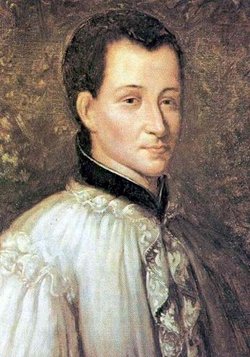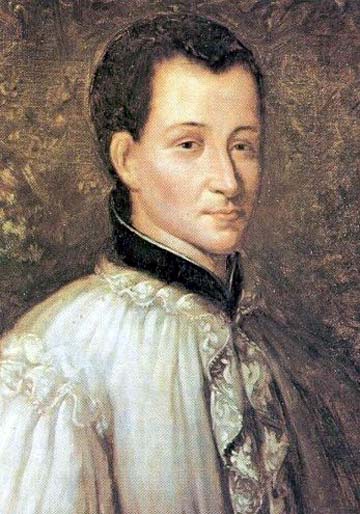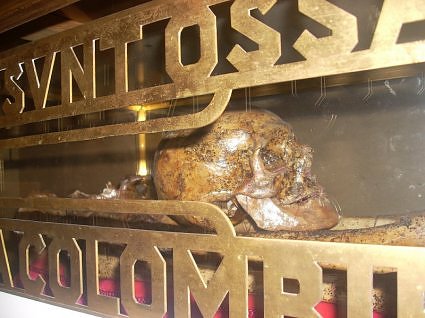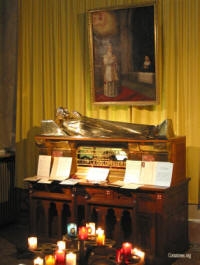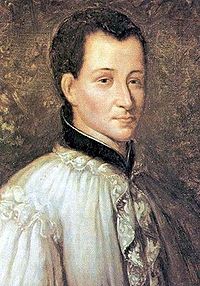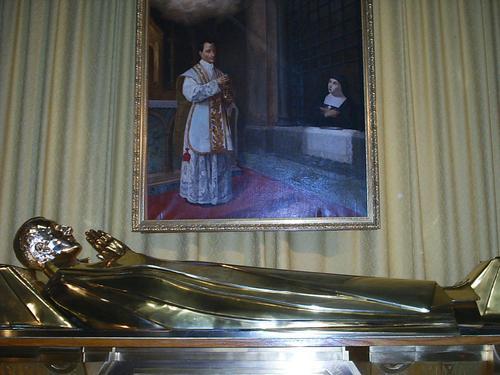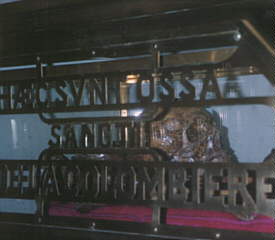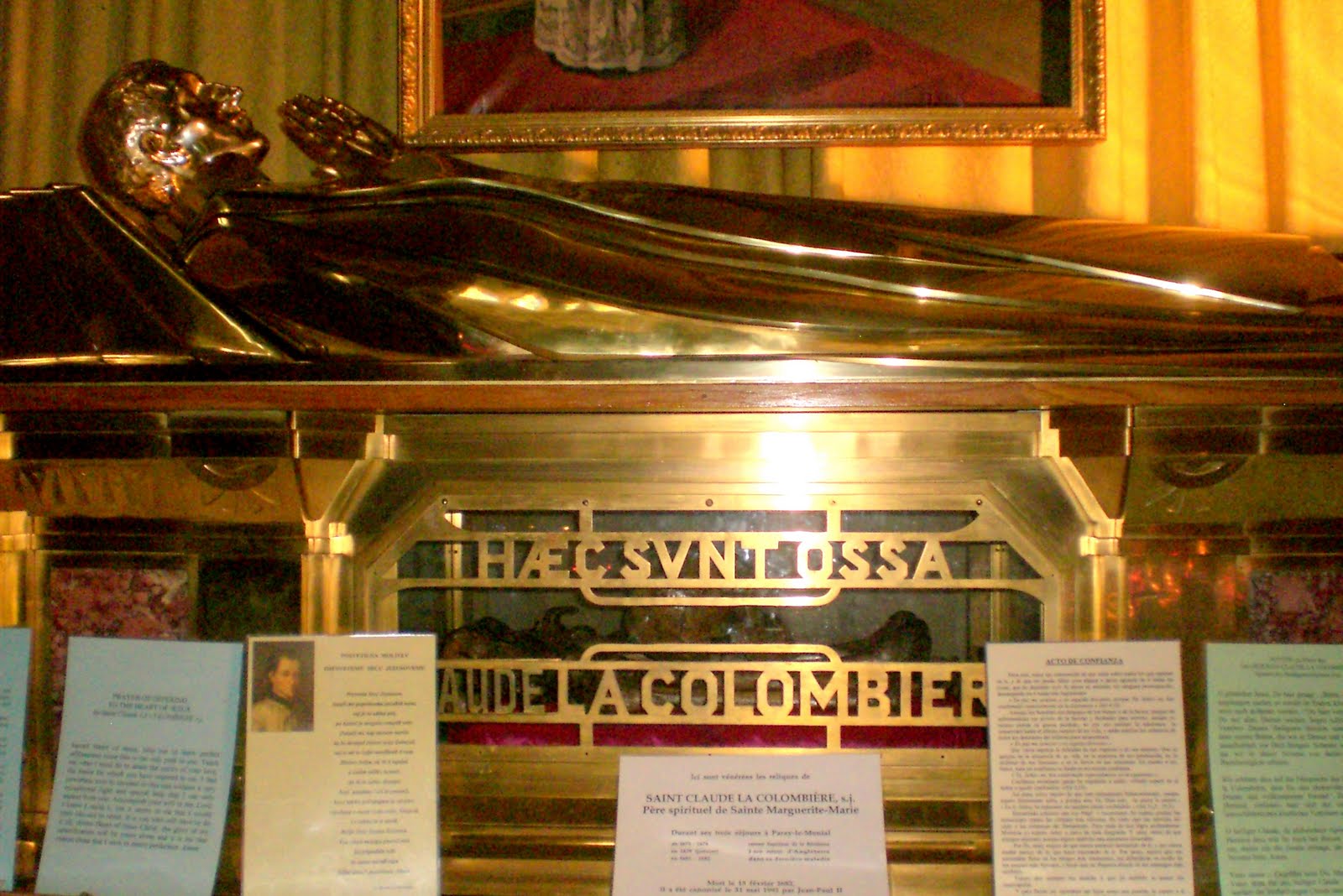Claude la Colombière, third child of the notary Bertrand la Colombière and Margaret (Coindat) la Colombière, was born on February 2, 1641 at Saint-Symphorien-d'Ozon in the Dauphine, southeastern France, near Lyon. After the family moved to Vienne, Claude began his early education there, completing his studies in rhetoric and philosophy in Lyon. It was during this period that Claude first sensed his vocation to the religious life in the Society of Jesus. We know nothing of the motives which led to this decision. We do know, however, from one of his early notations, that he "had a terrible aversion for the life embraced". This affirmation is not hard to understand by any who are familiar with the life of Claude, for he was very close to his family and friends and much inclined to the arts and literature and an active social life. On the other hand, he was not a person to be led primarily by his sentiments.
At 17, he entered the Jesuit Novitiate at Avignon. In 1660 he moved from the Novitiate to the College, also in Avignon, where he pronounced his first vows and completed his studies in philosophy. Afterwards he was professor of grammar and literature in the same school for another five years. In 1666, he went to the College of Clermont in Paris for his studies in theology. Already noted for his tact, poise and dedication to the humanities, Claude was assigned by superiors in Paris the additional responsibility of tutoring the children of Louis XIV's Munster of Finance, Jean Baptiste Colbert. His theological studies concluded and now a priest, Claude returned to Lyon. For a time he was teacher in the College, then full-time preacher and moderator of several Marian congregations. Claude became noted for solid and serious sermons.
On 2nd February 1675, he pronounced his solemn profession and was named rector of the College at Paray-le-Monial. At this time he became confessor and chaplain to the nun of the Monastery of the Visitation in Paray. After Father Colombière's arrival and her first conversations with him, Sr Margaret Mary Alacoque opened her spirit to him and told him of the many communications she believed she had received from the Lord. He accepted their authenticity and urged her to put in writing everything in their regard, and did all he could to orient and support her in carrying out the mission received. When, thanks to prayer and discernment, he became convinced that Christ wanted the spread of the devotion to his Heart, it is clear from Claude's spiritual notes that he pledged himself to this cause without reserve. In these notes it is also clear that, even before he became Margaret Mary's confessor, Claude's fidelity to the directives of St Ignatius in the Exercises had brought him to the contemplation of the Heart of Christ as symbol of his love.
After a year and half in Paray, in October 1676, Fr La Colombière left for St James Palace, London, in the last years of King Charles II. He had been appointed official chaplain to Mary of Modena, wife of James, the Duke of York - a very difficult and delicate assignment because of the conditions prevailing in England at the time. The intense pace of his work and the poor climate combined to undermine his health, and evidence of a serious pulmonary disease began to appear. Claude, however, made no changes in his work or life style. Of a sudden, at the end of 1678, he was calumniously accused and arrested in connection with the Titus Oates "papist plot". After two days he was transferred to the severe King's Bench Prison where he remained for three weeks in extremely poor conditions until his expulsion from England by royal decree. This suffering further weakened Claude's health which, with ups and downs, deteriorated rapidly on his return to France. As a sidenote, King Charles II officially converted to the Catholic faith on his deathbed, in 1685.
During the summer of 1681, he returned to Paray, in very poor condition. On February 15, 1682, the first Sunday of Lent, towards evening Claude suffered the severe hemorrhage which ended his life.
On the June 16, 1929, Pope Pius XI beatified Claude la Colombière, whose charism, according to St Margaret Mary Alacoque, was that of bringing souls to God along the gospel way of love and mercy which Christ revealed to us. He was canonized a saint by Pope John Paul II on May 31, 1992.
Brother: l'Abbe Joseph la Colombière∼Saint Claude de la Colombière (Saint-Symphorien-d'Ozon, 2 February 1641–Paray-le-Monial, 15 February 1682) was a Roman Catholic priest and the confessor of Saint Margaret-Marie Alacoque. His feast day is the day of his death, 15 February.
He was a missionary and ascetical writer, born of noble parentage at Saint-Symphorien-d'Ozon , between Lyon and Vienne, in 1641.
He entered the Society of Jesus in 1659. After fifteen years of religious life in the Jesuits, he made a vow, as a means of attaining the utmost possible perfection, to observe faithfully the Rule and Constitutions of his order under penalty of sin. Those who lived with him attested that this vow was kept with great exactitude.
In 1674, Claude was made superior at the Jesuit house at Paray-le-Monial, where he became the spiritual director of Saint Margaret-Marie Alacoque and was thereafter a zealous apostle of the devotion to the Sacred Heart of Jesus. In 1676, he was sent to England as preacher to Mary of Modena, Duchess of York, afterwards Queen of Great Britain. He lived the life of a religious even in the Court of St. James's (the official residence of the British Monarchy), and was as active a missionary in England as he had been in France. Although encountering many difficulties, he was able to guide Saint Margaret- Marie by letter.
His zeal soon weakened his vitality and a throat and lung infirmity seemed to threaten his work as a preacher. While awaiting his recall to France he was suddenly arrested and thrown into prison, denounced as a conspirator against the English throne. Thanks to his title of "Preacher to the Duchess of York" and to the protection of the King of France, Louis XIV, whose subject Claude was, he escaped death but was condemned to exile in 1679. The last two years of his life were spent at Lyon where he was spiritual director to the young Jesuits, and at Paray-le-Monial, where he returned to improve his health. His principal works, including "Pious Reflections", "Meditations on the Passion", "Retreat and Spiritual Letters", were published under the title, "Oeuvres du R. P. Claude de la Colombière" (Avignon, 1832; Paris, 1864).
He was beatified by Pope Pius XI on June 16, 1929, and canonized by Pope John Paul II on May 31, 1992.
His relics are preserved in the Jesuit Church around the corner from the monastery of the Visitation nuns at Paray-le-Monial.
From Wikipedia, the free encyclopedia.
∼Born Grenoble, France
French nobility who felt a call to religious life from an early age.
Educated at Jesuit college in Lyons, France.
Priest.
Taught humanities at Avignon.
Studied in Paris; tutor.
Preached against Jansenism, advocating dedication to the Sacred Heart of Jesus.
Jesuit.
Spiritual director of Saint Margaret Mary of Alocoque.
Chaplain to the Duchess of York, converting many Protestants through the example of his holy life.
"Popish" plots against the king, and the reestablishment Catholicism were rumored; Claude was imprisoned, accused of being part of the plot. It was only by the efforts of Louis XIV, who had recommended him for the assignment, that he was not martyred.
Banished from England. His health was ruined by prison. Returned to Paray to die.
Died at Paray-le-Monial of hemoptysis (coughing up blood)
Beatified on 16 June 1929 by Pope Pius XI
Canonized on 31 May 1992 by Pope Saint John Paul II
Claude la Colombière, third child of the notary Bertrand la Colombière and Margaret (Coindat) la Colombière, was born on February 2, 1641 at Saint-Symphorien-d'Ozon in the Dauphine, southeastern France, near Lyon. After the family moved to Vienne, Claude began his early education there, completing his studies in rhetoric and philosophy in Lyon. It was during this period that Claude first sensed his vocation to the religious life in the Society of Jesus. We know nothing of the motives which led to this decision. We do know, however, from one of his early notations, that he "had a terrible aversion for the life embraced". This affirmation is not hard to understand by any who are familiar with the life of Claude, for he was very close to his family and friends and much inclined to the arts and literature and an active social life. On the other hand, he was not a person to be led primarily by his sentiments.
At 17, he entered the Jesuit Novitiate at Avignon. In 1660 he moved from the Novitiate to the College, also in Avignon, where he pronounced his first vows and completed his studies in philosophy. Afterwards he was professor of grammar and literature in the same school for another five years. In 1666, he went to the College of Clermont in Paris for his studies in theology. Already noted for his tact, poise and dedication to the humanities, Claude was assigned by superiors in Paris the additional responsibility of tutoring the children of Louis XIV's Munster of Finance, Jean Baptiste Colbert. His theological studies concluded and now a priest, Claude returned to Lyon. For a time he was teacher in the College, then full-time preacher and moderator of several Marian congregations. Claude became noted for solid and serious sermons.
On 2nd February 1675, he pronounced his solemn profession and was named rector of the College at Paray-le-Monial. At this time he became confessor and chaplain to the nun of the Monastery of the Visitation in Paray. After Father Colombière's arrival and her first conversations with him, Sr Margaret Mary Alacoque opened her spirit to him and told him of the many communications she believed she had received from the Lord. He accepted their authenticity and urged her to put in writing everything in their regard, and did all he could to orient and support her in carrying out the mission received. When, thanks to prayer and discernment, he became convinced that Christ wanted the spread of the devotion to his Heart, it is clear from Claude's spiritual notes that he pledged himself to this cause without reserve. In these notes it is also clear that, even before he became Margaret Mary's confessor, Claude's fidelity to the directives of St Ignatius in the Exercises had brought him to the contemplation of the Heart of Christ as symbol of his love.
After a year and half in Paray, in October 1676, Fr La Colombière left for St James Palace, London, in the last years of King Charles II. He had been appointed official chaplain to Mary of Modena, wife of James, the Duke of York - a very difficult and delicate assignment because of the conditions prevailing in England at the time. The intense pace of his work and the poor climate combined to undermine his health, and evidence of a serious pulmonary disease began to appear. Claude, however, made no changes in his work or life style. Of a sudden, at the end of 1678, he was calumniously accused and arrested in connection with the Titus Oates "papist plot". After two days he was transferred to the severe King's Bench Prison where he remained for three weeks in extremely poor conditions until his expulsion from England by royal decree. This suffering further weakened Claude's health which, with ups and downs, deteriorated rapidly on his return to France. As a sidenote, King Charles II officially converted to the Catholic faith on his deathbed, in 1685.
During the summer of 1681, he returned to Paray, in very poor condition. On February 15, 1682, the first Sunday of Lent, towards evening Claude suffered the severe hemorrhage which ended his life.
On the June 16, 1929, Pope Pius XI beatified Claude la Colombière, whose charism, according to St Margaret Mary Alacoque, was that of bringing souls to God along the gospel way of love and mercy which Christ revealed to us. He was canonized a saint by Pope John Paul II on May 31, 1992.
Brother: l'Abbe Joseph la Colombière∼Saint Claude de la Colombière (Saint-Symphorien-d'Ozon, 2 February 1641–Paray-le-Monial, 15 February 1682) was a Roman Catholic priest and the confessor of Saint Margaret-Marie Alacoque. His feast day is the day of his death, 15 February.
He was a missionary and ascetical writer, born of noble parentage at Saint-Symphorien-d'Ozon , between Lyon and Vienne, in 1641.
He entered the Society of Jesus in 1659. After fifteen years of religious life in the Jesuits, he made a vow, as a means of attaining the utmost possible perfection, to observe faithfully the Rule and Constitutions of his order under penalty of sin. Those who lived with him attested that this vow was kept with great exactitude.
In 1674, Claude was made superior at the Jesuit house at Paray-le-Monial, where he became the spiritual director of Saint Margaret-Marie Alacoque and was thereafter a zealous apostle of the devotion to the Sacred Heart of Jesus. In 1676, he was sent to England as preacher to Mary of Modena, Duchess of York, afterwards Queen of Great Britain. He lived the life of a religious even in the Court of St. James's (the official residence of the British Monarchy), and was as active a missionary in England as he had been in France. Although encountering many difficulties, he was able to guide Saint Margaret- Marie by letter.
His zeal soon weakened his vitality and a throat and lung infirmity seemed to threaten his work as a preacher. While awaiting his recall to France he was suddenly arrested and thrown into prison, denounced as a conspirator against the English throne. Thanks to his title of "Preacher to the Duchess of York" and to the protection of the King of France, Louis XIV, whose subject Claude was, he escaped death but was condemned to exile in 1679. The last two years of his life were spent at Lyon where he was spiritual director to the young Jesuits, and at Paray-le-Monial, where he returned to improve his health. His principal works, including "Pious Reflections", "Meditations on the Passion", "Retreat and Spiritual Letters", were published under the title, "Oeuvres du R. P. Claude de la Colombière" (Avignon, 1832; Paris, 1864).
He was beatified by Pope Pius XI on June 16, 1929, and canonized by Pope John Paul II on May 31, 1992.
His relics are preserved in the Jesuit Church around the corner from the monastery of the Visitation nuns at Paray-le-Monial.
From Wikipedia, the free encyclopedia.
∼Born Grenoble, France
French nobility who felt a call to religious life from an early age.
Educated at Jesuit college in Lyons, France.
Priest.
Taught humanities at Avignon.
Studied in Paris; tutor.
Preached against Jansenism, advocating dedication to the Sacred Heart of Jesus.
Jesuit.
Spiritual director of Saint Margaret Mary of Alocoque.
Chaplain to the Duchess of York, converting many Protestants through the example of his holy life.
"Popish" plots against the king, and the reestablishment Catholicism were rumored; Claude was imprisoned, accused of being part of the plot. It was only by the efforts of Louis XIV, who had recommended him for the assignment, that he was not martyred.
Banished from England. His health was ruined by prison. Returned to Paray to die.
Died at Paray-le-Monial of hemoptysis (coughing up blood)
Beatified on 16 June 1929 by Pope Pius XI
Canonized on 31 May 1992 by Pope Saint John Paul II
